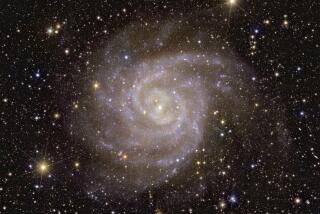Bright ancient galaxies offer rare glimpse of early universe
- Share via
A quartet of galaxies spied with NASA’s Hubble Space Telescope are among the oldest yet discovered — more than 13 billion years old, born just 500 million years after the big bang. They’re also incredibly bright, so luminous that they offer a new peek into the early universe.
The findings, announced Tuesday at the American Astronomical Society meeting in Maryland, shed light on the growth and development of some of the earliest galaxies. They also provide hope that NASA’s infrared-optimized James Webb Space Telescope, set to launch in 2018, will be able to see even more from this obscure era in the universe’s history.
The scientists used data from the Hubble Space Telescope and the Spitzer Space Telescope, which can peer through the dust and gas pervading the universe to extremely distant stars and galaxies. The more distant the target, the longer the light has been traveling, and the older the object seen is.
“When we look at these galaxies, we are using Hubble as a time machine,” said study coauthor Garth Illingworth, an astronomer at UC Santa Cruz. “These galaxies are almost primeval in a sense.… We have to understand how [they] came about.”
The four galaxies are about 20 times brighter than they ought to be, the researchers said. Their bluish light reveals that they’re bursting with star formations — the brightest one is producing stars 50 times faster than the Milky Way. If scientists were able to see them in real time, they would potentially dwarf Earth’s galaxy, said lead author Pascal Oesch, an astronomer at Yale University.
But at the ancient time in which these distant galaxies can be observed, they are very small — taking up something like 1/20th the space of the Milky Way — though they are densely packed. If the Milky Way represented Los Angeles’ urban sprawl, these galaxies would be Manhattan.
“It’s sort of like a busy, congested downtown area with a lot of activity and a lot of people wandering around wearing bright blue lights,” Illingworth said.
Astronomers recently have found many galaxies from not long after the big bang, but none so bright. These newly observed beacons are so brilliant that they can be studied directly with ground-based telescopes.
Opinions differed Tuesday as to whether the findings were surprising or not. Caltech astronomer Richard Ellis, who was not involved in the study, said it did not seem surprising that these galaxies existed in such an early time in the universe.
However, UC Irvine astronomer James Bullock, who also did not work on the study, called the findings intriguing, noting that the young universe might have been a lot more random, a lot lumpier, than astronomers sometimes think.
“There’s something interesting going on, possibly triggering galaxies to form faster in certain parts of the universe than others,” he said.







